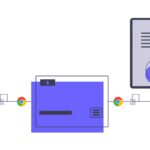SaaS (Software as a Service) has taken the cloud-based computing world by storm and shows no signs of letting up anytime soon. In fact, it will comprise “more than half of all public cloud services this year,” according to the International Data Corporation (IDC), meaning that SaaS is setting trends and keeping the bar high for cloud-based services.
What’s more, SaaS is projected to strengthen its dominance on a global scale as companies embrace the idea of using cloud-based computing over more traditional locally-based software solutions. And as evidence of its incredible power, SaaS is expected to reach $185.8 billion by 2024, according to KBV Research.
Setting the Bar High
The SaaS industry is seeing unprecedented growth even as it constantly evolves. As a result, SaaS companies need to change up their own processes and strategies to meet the growing needs of the industry, setting trends left and right in turn that everyone needs to be aware of.
The need for awareness is directly related to the ways in which the constantly changing SaaS landscape affects businesses that make use of SaaS solutions. This means that not only do SaaS companies need to keep these trends in mind in order to stay ahead of the curve, but so do a wide range of other industries, including manufacturing, healthcare, retail, and more.
Ignoring these trends could come at a disastrous fate. If companies aren’t ready to grow along with the digital revolution, they could face a terrible cost: being left behind and forgotten in favor of the competition that’s at the forefront of the changes sweeping our world.
6 Powerful SaaS Trends
So what are these trends? In a large way, they all relate to improved user experience, which makes a lot of sense. After all, not only do the most popular apps have the best overall user experiences, but businesses will want to utilize SaaS solutions that are the easiest to embrace. With that in mind, these are 6 trends to watch this year in the SaaS world.
1. AI/Machine Learning
Artificial Intelligence is absolutely critical to our world today. Although the technology’s early days date back decades, AI is something that we are coming to rely on even more, perhaps without realizing it.
SaaS is no exception. And in reality, AI has been a major component of SaaS since the industry’s inception, especially some of the names with big brand recognition, like Amazon’s Alexa. However, AI is rapidly developing into more than a desirable add-on feature.
Stronger AI incorporation is becoming an in-demand aspect that can make or break whether a business chooses a SaaS solution.
The best SaaS apps use AI to anticipate a user’s wants and needs in order to offer fewer suggestions that are better tailored to each user. In turn, users are more likely to select those apps with more customized suggestions. This offers a major improvement over older versions that offered a huge menu, forcing users to sort and sift through to find the most relevant options.
AI contributes to SaaS in a huge variety of other ways as well, running the gamut from better marketing, improved security, and increased automation. It follows that all of these contribute to stronger engagement and better overall user experience.
2. Data Security
As data security becomes simultaneously more important and more fragile, SaaS is expected to lead the charge on improving how we protect our data. One possible avenue for this is blockchain technology. Although blockchain was initially formed for cryptocurrencies, it has a great deal of relevance to SaaS as well. Stephen Cummins of AppSelekt appears to also agree with this theory.
Safe, fast data transfers and payments are critical to the continuing success of SaaS. After all, switching from a local application-based system to a SaaS system can be a massive undertaking, not just in terms of money, but also in terms of time.
The businesses that are continuing to invest in SaaS will need to see their investment pay off, so they will choose the SaaS solutions that offer the most streamlined approach to the transition. After all, retraining a team on new apps and new processes can be incredibly costly, so the SaaS companies with the most seamless and safe data transfers will get a bigger chunk of the pie.
Whether SaaS companies use blockchain, APIs, integrations, or some combination of the three, if the overall user – and company – experience with data transfers is positive, they’ll enjoy a very welcome reception and continued use of their product.
3. Going Mobile
Everything is moving towards better mobile usability, so it makes a lot of sense that SaaS is going this route as well. After all, people spend a great deal of time on their smartphones, so SaaS companies that meet their users where they want to be – on the go – will have a leg up over their competition.
This ties back into the user experience, and by making it increasingly easy for people to use their app, SaaS companies will see increased growth as well.
The key here will be offering great functionality, as lots of mobile apps trade functionality and features for the convenience of mobile use. Many productivity and communications apps are ahead in this aspect and already offer functionalities and features corresponding with the non-mobile versions.
Although the non-mobile versions are definitely still needed, SaaS companies are continuing to find new ways to make their mobile versions comparable. And ultimately, SaaS companies with the most robust mobile apps will continue to lead their competition.
4. Using Data to Determine Pricing
As SaaS continues to grow as a global industry, pricing will become more streamlined and data-driven. Companies choose SaaS in part for convenience, but primarily for the huge cost of savings. Leveraging the data to determine pricing can help SaaS find a happy medium of the cost between supporting their customers’ needs and providing the best valuation of their services.
Subscription-based pricing models are the most common for SaaS companies, which can help provide a consistent income and is especially beneficial during the start-up phase. However, for SaaS companies whose clients use their services sporadically or for a limited time, a pay-per-use or pay-per-feature model may be a better option. Those models may be easier to meet the clients at the time where they need the product the most, again coming down to the user experience.
A data-driven approach to pricing – whether on a subscription basis, a pay-per-use model, or a combination that best meets clients’ needs – will help SaaS companies determine what their clients’ are most looking for. Ultimately, they can leverage those needs to continue to grow their bottom lines.
5. White Label Services
White label services are highly sought after in today’s business world. It makes a company appear to be increasingly powerful and be perceived as the expert their own client base needs.
As the SaaS industry expands, including the ways they integrate into their customers’ websites, apps, and other interfaces, the value of white label services will grow as well.
Businesses will continue to want to present SaaS solutions as a key component of their own branding. And not only will they want to remove any “powered by” code from within their interfaces, but they’ll also want all integrations to match up with their existing look and feel, with minimal adjustments required.
SaaS companies that offer this service will find themselves ahead of the pack.
6. Better Brand Recognition
As
SaaS continues to grow, the need for strong brand recognition will
grow right along with it. After all, the number of competitors is
increasing and shows no signs of slowing down. For a SaaS company to
stay ahead, they’ll need to develop their own strong brand
messaging and consistently use it on all their platforms.
The
concept of a strong brand goes far beyond the identity components of
choosing a professional logo and colors. A SaaS company’s brand
should expand into their copy and content as well. After all, the
overall user experience for consistent messaging, a consistent look
and feel, and consistent voice and tone are critical to attracting
the right audience. For example, if one area of content or copy is
very technical and formally worded, while the next is very casual and
easy-to-read, users will experience brand confusion rather than a
cohesive experience.
By taking the time to build a solid, well-organized experience for their users, SaaS companies will build a brand that consistently delivers to their users, instead of potentially alienating or confusing them.
The Bottom Line of 2019 SaaS Trends
There’s no doubt the digital revolution is here. SaaS remains at the forefront of our evolving digital world as it consistently takes the technological race to new frontiers. Furthermore, SaaS will comprise “more than half of all public cloud services” in 2019, according to the International Data Corporation (IDC).
These trends offer exciting areas to watch, as SaaS brings countless other industries along for the ride. The rest of the world will need to keep an eye on the trends set by SaaS in order to learn how to use SaaS to not only improve their own services, but also to see how the changing landscape will affect their own business.
Interested to know more?
VSH team has more than 8 years of experience in SaaS Software development services and is a well-known SaaS product Development Company providing solutions across industries. With VSH as your SaaS solutions provider, you can: leverage VSH SaaS platform to accelerate the development, gain access to cloud PaaS development expertise, can reduce release cycles by our DevOps expertise and cut SaaS application development costs through economically viable delivery models.
Please submit the form below to know more about our success stories and schedule a consultation call with our expert SaaS software developers.



